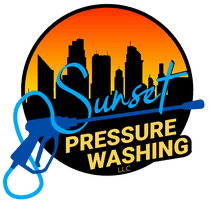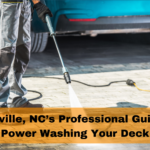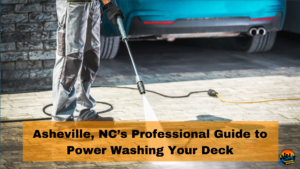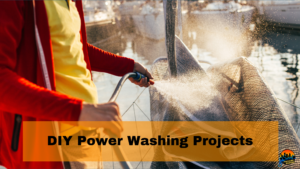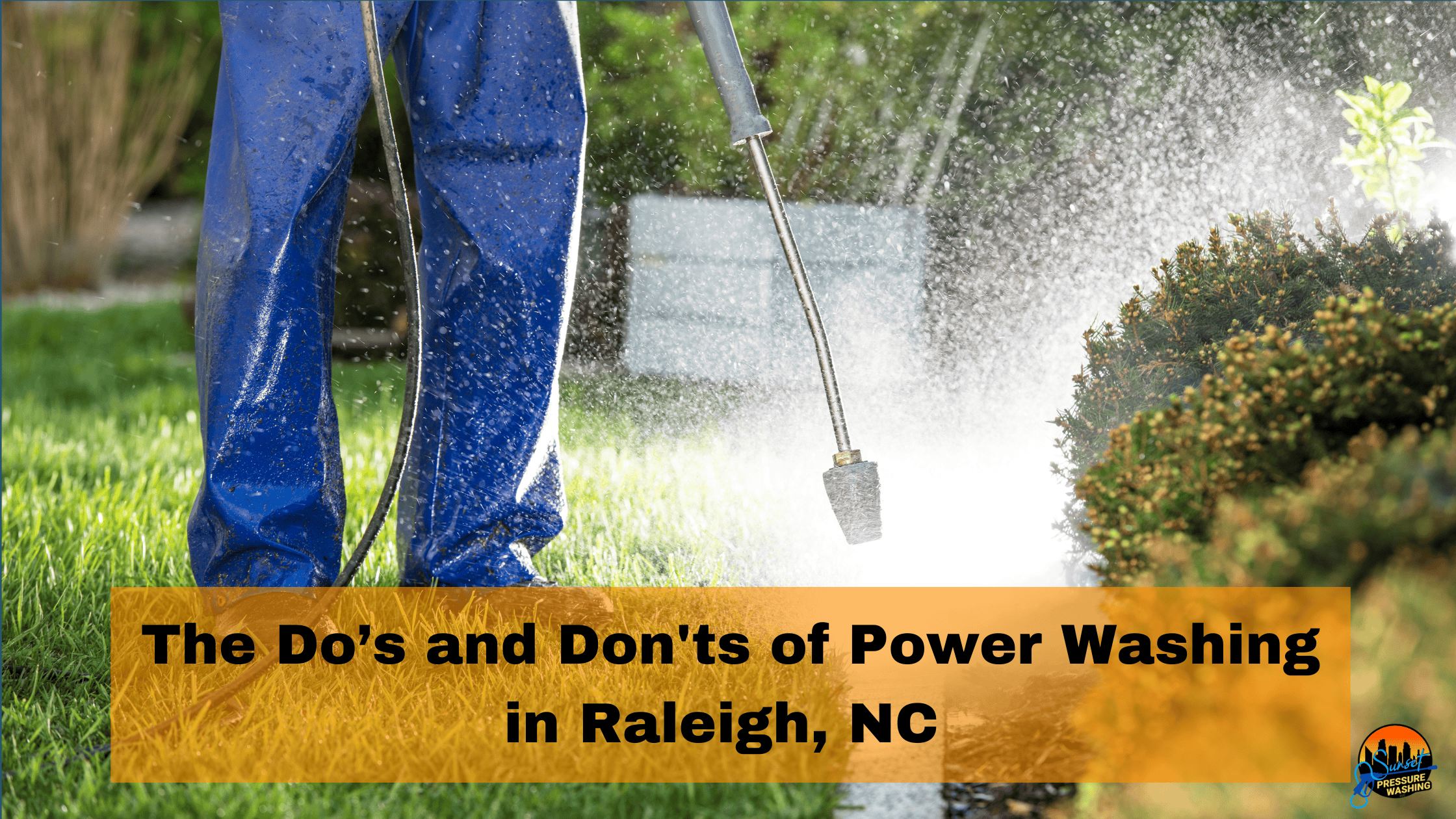
The Do’s and Don'ts of Power Washing in Raleigh, NC
Power washing can be a game-changer when it comes to maintaining the appearance and longevity of your home or business. However, it’s essential to approach this task with the right knowledge and tools to avoid damage and achieve the best results. In this blog, we’ll cover the do’s and don’ts of power washing in Raleigh, NC, to ensure you’re well-prepared for your next cleaning project.
Do Understand the Local Climate
Raleigh, NC, experiences a humid subtropical climate characterized by hot, humid summers and mild winters. This climate can cause the rapid buildup of mold, mildew, and algae on exterior surfaces, making regular power washing essential for maintaining the appearance and integrity of your property.
Seasonal Timing for Power Washing
The best time to power wash in Raleigh is during the spring and fall. These seasons offer moderate temperatures and lower humidity levels, allowing surfaces to dry more thoroughly and reducing the risk of mold and mildew growth.
Impact of Humidity
High humidity levels in Raleigh can cause surfaces to stay wet for longer periods, promoting the growth of mold and algae. Power washing during drier periods can help mitigate these effects, ensuring a cleaner and more effective result.
Managing Mold and Mildew
Given Raleigh’s humid environment, mold and mildew are common issues. Using appropriate cleaners and power washing techniques can effectively remove these growths and prevent their recurrence, protecting your property from potential damage and health hazards.
Adjusting Pressure Levels
In Raleigh’s varied climate, different surfaces may require different pressure settings. For instance, wood decks may need lower pressure to avoid damage, while concrete driveways can handle higher pressure. Understanding the local climate helps in selecting the right settings.
Protecting Against Pollen
Springtime in Raleigh brings high pollen levels, which can accumulate on surfaces and mix with moisture to form a stubborn residue. Regular power washing during and after pollen season helps keep your property looking fresh and clean.
Considering Rainfall Patterns
Frequent rain showers in Raleigh can impact your power washing schedule. It’s best to avoid washing right before a forecasted rain to ensure that cleaning solutions have adequate time to work and surfaces have time to dry.
Preparing for Winter
While Raleigh winters are mild, occasional freezing temperatures can occur. It’s important to clean surfaces thoroughly before winter sets in to prevent dirt and grime from becoming more challenging to remove in colder weather.
Do Use the Right Equipment
Different surfaces require different pressure levels. For light-duty tasks like cleaning cars and outdoor furniture, use a pressure washer with a PSI of 1300-2000. For heavy-duty tasks like driveways and heavily stained surfaces, opt for a washer with a PSI of 2800-4000.
Selecting the Right Nozzles
Pressure washers come with various nozzle tips, each designed for specific tasks. A 0-degree nozzle delivers a concentrated stream for tough stains, while a 40-degree nozzle provides a wider spray for general cleaning. Choose the appropriate nozzle for each task to avoid damage and ensure effective cleaning.
Using the Right Attachments
Attachments like surface cleaners, extension wands, and soap applicators can enhance your power washing efficiency. Surface cleaners are great for large, flat areas, while extension wands help you reach high places without a ladder. Soap applicators ensure even distribution of cleaning solutions.
Ensuring Proper Water Supply
A steady and sufficient water supply is crucial for effective power washing. Ensure your garden hose is free of kinks and that your water source provides adequate flow. Check the pressure washer’s manual for the recommended water flow rate to avoid equipment damage.
Understanding Electric vs. Gas Pressure Washers
Electric pressure washers are generally quieter and require less maintenance, making them suitable for small to medium tasks. Gas pressure washers are more powerful and mobile, ideal for larger areas and tougher jobs. Choose the type that best suits your needs.
Regular Equipment Maintenance
Regular maintenance of your pressure washer is essential for optimal performance and longevity. Clean the nozzles, check hoses for leaks, and ensure the motor is functioning correctly. Proper maintenance prevents breakdowns and extends the life of your equipment.
Safe Storage Practices
Store your pressure washer in a dry, sheltered area to protect it from the elements. Drain any remaining water from the pump and hoses to prevent freezing and damage, especially during Raleigh’s colder months.
Renting vs. Buying Equipment
Consider the frequency and scale of your power washing needs when deciding between renting and buying equipment. If you only need to power wash occasionally, renting might be more cost-effective. For regular use, investing in a quality pressure washer can save you money in the long run.
Do Wear Safety Gear
Power washing can be hazardous due to the high-pressure water jets and the potential for flying debris. Wearing safety gear is essential to protect yourself from injuries and ensure a safe cleaning process.
Protective Gloves
Wearing durable, waterproof gloves is crucial when power washing. Gloves protect your hands from high-pressure water streams, harsh chemicals, and sharp debris that might be dislodged during cleaning.
Safety Goggles
Safety goggles shield your eyes from water spray, cleaning agents, and debris. They prevent eye injuries and ensure clear vision throughout the power washing process. Always choose goggles that fit snugly and provide a wide field of vision.
Non-Slip Footwear
Non-slip, waterproof footwear is essential to prevent slips and falls, especially when working on wet surfaces. Sturdy, closed-toe shoes or boots offer the best protection for your feet and provide stability during power washing tasks.
Protective Clothing
Wearing long sleeves, pants, and a waterproof apron or suit can protect your skin from high-pressure water jets and cleaning chemicals. Choose clothing that allows freedom of movement while providing adequate coverage.
Hearing Protection
Some pressure washers, especially gas-powered models, can be quite loud. Using earplugs or earmuffs helps protect your hearing, reducing the risk of long-term hearing damage from prolonged exposure to loud noises.
Respiratory Protection
When using chemical cleaners, wearing a mask or respirator can prevent inhalation of harmful fumes. This is particularly important in enclosed spaces or areas with poor ventilation. Choose a mask appropriate for the chemicals you are using.
Face Shield
For added protection, especially when dealing with stubborn stains or using abrasive cleaning agents, a face shield can provide an extra layer of safety for your face and neck. This helps prevent injuries from flying debris and splashes.
Do Test on a Small Area First
Testing on a small, inconspicuous area helps you understand how the surface will react to power washing. This precautionary step can prevent extensive damage and ensure the cleaning method and pressure settings are appropriate for the material.
Identifying Sensitive Areas
Before starting, identify areas that might be more sensitive to high-pressure water, such as painted surfaces, wood, or older materials. Testing these spots first can save you from causing irreversible damage.
Choosing the Test Spot
Select a small, hidden section of the surface you plan to clean. For example, if you’re washing a deck, choose a corner or an area under furniture. This minimizes visibility if any damage occurs during the test.
Adjusting Pressure Settings
Start with the lowest pressure setting on your washer. Gradually increase the pressure until you find the right balance that cleans effectively without damaging the surface. This step is crucial for delicate materials like wood or painted surfaces.
Checking for Damage
After testing, inspect the area closely for any signs of damage such as chipping paint, splintered wood, or etched concrete. If you notice any damage, adjust the pressure, nozzle, or cleaning method accordingly.
Testing Cleaning Solutions
If you’re using detergents or chemical cleaners, test them on the small area first. Some solutions can be too harsh for certain surfaces, leading to discoloration or damage. Ensure the cleaner is safe and effective before applying it to a larger area.
Evaluating Effectiveness
Assess the effectiveness of the cleaning method after testing. If the test spot comes out clean without any damage, you can proceed with confidence. If not, consider adjusting your approach or using a different cleaning technique.
Repeating Tests for Different Surfaces
Different surfaces around your property might require different settings and cleaning methods. Conduct tests on each type of surface to ensure optimal cleaning results without causing harm. This approach is especially important for varied materials like brick, wood, and vinyl siding.
Don't Use Excessive Pressure
Excessive pressure can cause significant damage to various surfaces. Different materials require different pressure levels to clean effectively without harm. Understanding the appropriate PSI (pounds per square inch) for each surface is crucial for safe power washing.
Risks of High Pressure
Using too much pressure can strip paint, splinter wood, and etch concrete, leading to costly repairs. High pressure can also force water into areas where it shouldn’t go, such as under siding or into cracks, causing water damage and mold growth.
Suitable Pressure for Different Surfaces
- Wood Surfaces: For decks and fences, keep the pressure between 500-1200 PSI. Higher pressure can splinter and damage the wood fibers.
- Concrete and Brick: These tougher materials can handle up to 3000 PSI, but start lower and increase as needed to avoid etching the surface.
- Vinyl Siding: Use a pressure between 1300-1600 PSI. High pressure can crack or dislodge siding panels.
- Painted Surfaces: Use low pressure (500-1200 PSI) to avoid stripping the paint unless repainting is the goal.
Testing Pressure Levels
Always start with the lowest pressure setting and gradually increase until you find the effective level for cleaning. Testing on a small area first helps ensure the chosen pressure is safe and effective for the entire surface.
Proper Distance and Angle
Maintaining the correct distance and angle is essential to prevent damage. Hold the nozzle at least 6-12 inches from the surface and at a 45-degree angle. This allows effective cleaning without the risk of gouging or damaging the material.
Using Appropriate Nozzles
Select the right nozzle for the job. A wider spray pattern (25-40 degrees) is generally safer for most surfaces. Narrower nozzles (0-15 degrees) concentrate the pressure and can cause damage if not used carefully. Switch to a wider nozzle if you notice any signs of damage.
Recognizing Signs of Damage
Be vigilant for signs of damage such as splintering, cracking, or etching while power washing. If you notice any issues, stop immediately, reduce the pressure, or adjust your technique to prevent further harm.
Don't Ignore Detergents and Cleaners
Detergents and cleaners can significantly enhance the efficiency of your power washing. They help break down tough grime, mold, mildew, and dirt, allowing you to clean surfaces more effectively with less effort and lower pressure settings.
Choosing the Right Cleaner
Different surfaces and stains require different cleaning solutions. Choose a cleaner specifically formulated for the type of surface you’re washing. For example, use a deck cleaner for wood surfaces, a concrete cleaner for driveways, and a mildew remover for moldy areas. Reading product labels ensures you select the appropriate cleaner for your needs.
Pre-Treating Stains
Pre-treating stubborn stains with a suitable detergent can make power washing more effective. Apply the cleaner to the stained area and let it sit for the recommended time to loosen dirt and grime before rinsing with the power washer. This process helps achieve a thorough clean without using excessive pressure.
Using the Soap Dispenser
Many pressure washers come with a built-in soap dispenser or attachment for applying detergents. Use this feature to evenly distribute the cleaner over the surface. Follow the manufacturer’s instructions for mixing and applying the detergent to ensure optimal performance.
Avoiding Harsh Chemicals
While it might be tempting to use strong chemicals for tough stains, harsh cleaners can damage surfaces and harm the environment. Opt for environmentally friendly, biodegradable cleaners that are safe for your property and surrounding areas.
Rinsing Thoroughly
After applying the detergent and letting it work, rinse the surface thoroughly with clean water. This step is crucial to remove any residual cleaner, which can leave streaks or damage the surface if left to dry. Ensure all soap and dirt are completely washed away.
Protecting Plants and Landscaping
When using detergents, take precautions to protect nearby plants and landscaping. Cover plants with plastic sheeting or water them before and after applying the cleaner to dilute any potential runoff. This helps prevent damage to your greenery from harsh chemicals.
Following Manufacturer Instructions
Always follow the instructions provided by the cleaner manufacturer. This includes dilution ratios, application methods, and safety precautions. Proper use of detergents ensures effective cleaning without causing harm to surfaces or the environment.
Combining Cleaning Methods
For particularly stubborn stains, consider combining the use of detergents with gentle scrubbing. A soft brush can help work the cleaner into the surface, loosening dirt and grime before rinsing. This approach maximizes the effectiveness of both the detergent and the power washer.
Safety Precautions
Wear protective gear, such as gloves and goggles, when handling and applying cleaning solutions. Some detergents can be irritating to the skin and eyes, so taking proper safety precautions is essential to avoid injury.
Do Follow Manufacturer Instructions
Every pressure washer has specific capabilities and limitations. Familiarize yourself with your machine by thoroughly reading the manufacturer’s instructions. This knowledge helps you use the equipment effectively and avoid potential issues.
Safety Guidelines
Manufacturer instructions include essential safety guidelines to protect you and your property. Follow these guidelines to prevent accidents, such as electric shocks, burns, or equipment malfunction. Safety precautions might include proper grounding, safe handling of the machine, and the correct way to start and stop the equipment.
Proper Setup
Correct setup is crucial for the effective operation of your pressure washer. Manufacturer instructions provide detailed steps on how to assemble and prepare the machine for use. This includes attaching hoses, nozzles, and any additional accessories correctly to ensure everything functions as intended.
Using the Right Nozzles
Different nozzles are designed for various tasks. Manufacturer instructions will specify which nozzles are suitable for different surfaces and types of cleaning. Using the right nozzle ensures efficient cleaning and prevents damage to your surfaces.
Recommended Pressure Settings
The instructions will outline recommended pressure settings for different cleaning tasks. Adhering to these settings helps you achieve optimal cleaning results without causing harm to surfaces. For example, low pressure is recommended for delicate surfaces like wood, while higher pressure can be used for tough surfaces like concrete.
Detergent Use
If your pressure washer supports the use of detergents, the manufacturer will provide guidance on which types of cleaners are safe to use with your machine. They will also include instructions on how to properly mix and apply detergents using the pressure washer’s soap dispenser or injector system.
Maintenance Procedures
Regular maintenance is key to the longevity and performance of your pressure washer. Manufacturer instructions will include maintenance procedures such as cleaning filters, checking hoses for leaks, and storing the machine properly. Following these procedures helps prevent breakdowns and extends the life of your equipment.
Troubleshooting Tips
If your pressure washer isn’t working correctly, the manufacturer’s instructions often include troubleshooting tips to help diagnose and fix common problems. This can save you time and money by addressing minor issues yourself without needing professional repair services.
Warranty Compliance
Following the manufacturer’s instructions is essential for warranty compliance. Using the machine in ways not recommended by the manufacturer can void your warranty, leaving you responsible for any repairs or replacements.
Environmental Considerations
Manufacturer instructions may include information on the environmental impact of using the pressure washer and how to minimize it. This can include proper disposal of used detergents, reducing water usage, and recommendations for environmentally friendly cleaning solutions.
Don't Power Wash in Direct Sunlight
Direct sunlight can affect the efficiency and outcome of your power washing efforts. The heat from the sun can cause water and cleaning solutions to evaporate quickly, leading to uneven cleaning and potential streaking.
Quick Drying Issues
Power washing in direct sunlight can cause surfaces to dry too quickly. This rapid drying can leave behind soap residue and water spots, making your cleaning job look incomplete and requiring additional rinsing or cleaning.
Increased Surface Temperature
Surfaces exposed to direct sunlight can become extremely hot, especially during Raleigh’s warm months. High surface temperatures can cause cleaning solutions to evaporate too fast, reducing their effectiveness and making it harder to remove dirt and grime.
Avoiding Damage to Surfaces
Some materials, such as wood and vinyl, can be more susceptible to damage when they are hot. Power washing these surfaces while they are heated by the sun can lead to warping, cracking, or other types of damage. Waiting for cooler conditions can help protect these materials.
Optimal Cleaning Times
The best times to power wash are during the early morning or late afternoon when the sun is not as intense. These times of day offer cooler temperatures and less direct sunlight, allowing cleaning solutions to work effectively without evaporating too quickly.
Monitoring Weather Conditions
Check the weather forecast before planning your power washing project. Choose a day with overcast skies or mild temperatures to ensure optimal conditions for cleaning. Avoid days with intense sunlight or extreme heat to prevent quick drying and potential surface damage.
Using Shade to Your Advantage
If possible, plan your power washing project in sections based on the natural shade provided by trees, buildings, or other structures. Working in shaded areas can help maintain cooler surface temperatures and improve the effectiveness of your cleaning efforts.
Keeping Surfaces Wet
If you must power wash in sunny conditions, keep the surface wet by regularly spraying it with water. This helps prevent the cleaning solution from drying too quickly and ensures a more even and thorough cleaning.
Achieve Pristine Clean with Expert Power Washing
Power washing service in Raleigh NC can transform the look of your property, but it’s essential to follow the right practices to avoid damage and ensure optimal results. By understanding Raleigh’s climate, using the right equipment, wearing safety gear, testing on small areas, and protecting your surroundings, you can achieve a pristine clean safely and effectively. For professional results and peace of mind, consider pressure washing services in Raleigh NC from Sunset Pressure Washing. Our expert team is equipped to handle all your power washing needs, ensuring your property looks its best. Visit Sunset Pressure Washing to learn more and schedule your service today.
